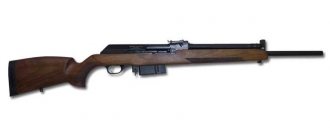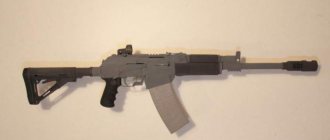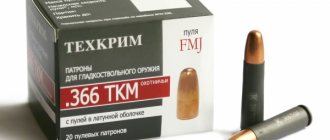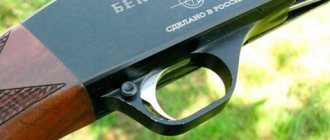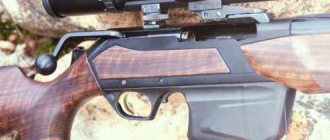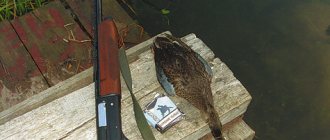The Vepr-308 carbine (SOK-95) is a rifled self-loading carbine chambered for the 7.62×51 (.308 Winchester) cartridge. The Vepr-308 carbine (SOK-95), as well as its improved modification Vepr-308 Super (SOK-95M), are one of the most popular models among the rifled carbines of the Vepr family. Like all carbines of the family, Vepr-308 was developed and produced at the Vyatsko-Polyansky Machine-Building Plant. The design of the carbine is based on the reliable and time-tested design of the Kalashnikov light machine gun. Vepr-308 carbines are designed for amateur and commercial hunting of medium and large animals.
History of the Vepr-308 carbine
The first carbine from the Vepr carbine family, the Vepr SOK-94 was created in 1995 at the Vyatsko-Polyansky Machine-Building Plant. It was a hunting carbine chambered for 7.62x39 mm.
In the nineties, the Vyatsko-Polyansky plant was actually left without state military orders and, for its own survival, was forced to rebuild its production to produce civilian products. As a result, the Vepr carbine appeared.
The Vepr carbine was created on the basis of the Kalashnikov light machine gun (RPK), which was also produced at the Vyatsko-Polyansky Machine-Building Plant. The design of the carbine makes maximum use of parts and components of the Kalashnikov light machine gun. From its predecessor, the Vepr carbine inherited a high degree of reliability and reliability when operating in the most difficult operating conditions.
The Vyatsko-Polyansky plant “Molot” produced Kalashnikov light machine guns for many years and had proven production technologies. Thanks to the use of parts and components from the Kalashnikov light machine gun (RPK), minimal changes in production technologies were required to establish the production of the carbine.
The second model of the Vepr carbine produced by the plant was the Vepr-308 (SOK-95) carbine chambered for 7.62×51 mm (.308 Winchester). In 1998, the plant launched the production of two improved modifications of the Vepr-308 carbine, they became the Vepr-308-Super carbine (SOK-95M) and the Vepr-308-Super-Sport carbine (SOK-95MS). The Vepr-308-Super-Sport carbine is currently out of production, the Vepr-308 Super carbine is still produced to this day.
Thanks to the ballistic characteristics of the 7.62x51 mm cartridge (.308 Winchester), Vepr-308 carbines have become one of the most popular among hunters in the Vepr line of rifled carbines.
Technical characteristics of Vepr-308
Vepr-308 carbines have the following technical characteristics:
- Type:
self-loading carbine, operating on the principle of using the removal of part of the powder gases from the barrel - Caliber:
7.62×51 (.308 Winchester) - Barrel length:
420, 520, 590, 700 mm - Magazine:
detachable plastic box magazine with single-row cartridge arrangement - Magazine capacity:
2, 3, 5 or 10 rounds - Sighting range:
300 m - Total length:
1215 mm (Vepr-308) 1040 mm (Vepr-308-Super) - Overall width:
75 mm - Overall height:
200 mm - Weight without magazine:
4.33 kg (Vepr-308) 3.9 kg (Vepr-308-Super) - Weight with magazine:
4.44 kg (Vepr-308) 4.3 kg (Vepr-308-Super)
Design of Vepr carbines
Trunk
The Vepr-308 (SOK-95) carbine can have a barrel length of 420, 520, 590 or 700 mm. The Vepr-308 Super carbine (SOK-95M) is equipped with a barrel length of 550 or 650 mm. The Vepr-308 (SOK-95) and Vepr-308 Super (SOK-95M) carbines are designed for the 7.62×51 rifled cartridge (.308 Winchester). To increase service life, the barrel bore and chamber of the carbine are chrome-plated. The barrel of the Vepr-308 (SOK-95) carbine is threaded for muzzle devices. The barrel of the Vepr-308 Super (SOK-95M) carbine has a slot-type muzzle brake.
Shutter and automation
The design of the Vepr carbine makes maximum use of parts and components of the Kalashnikov light machine gun. Reloading of the carbine is carried out by using the energy of the powder gases, which are discharged from the barrel bore into the gas chamber at the moment of firing, and the energy of the return spring. The barrel bore is locked by rotating the bolt around its axis by three lugs while moving the bolt frame longitudinally.
Trigger mechanism
The hammer-type trigger mechanism ensures the production of a single shot and the safety of the carbine. Unlike the Kalashnikov light machine gun, the Vepr carbines have a self-timer removed from the trigger mechanism, which allows firing in bursts. The Vepr-308 (SOK-95) carbine has a flag-type safety, while the Vepr-308 Super (SOK-95M) carbine has a push-button type safety.
Shop
Vepr-308 carbines are fed with cartridges from detachable box magazines with single-row cartridges. The carbine can be equipped with a magazine for 2, 3, 5, 8 or 10 rounds.
Sights
The Vepr-308 (SOK-95) and Vepr-308 Super (SOK-95M) carbines are equipped with open sights, consisting of an aiming bar (rear sight) and a front sight.
For the Vepr-308 (SOK-95) carbine, the front sight is located on the muzzle end of the barrel; for the Vepr-308 Super (SOK-95M) carbine, the front sight is located on the gas chamber block.
The open sight of the Vepr-308 carbines allows shooting at a distance of up to 300 meters. Most owners of Vepr-308 carbines equip their weapons with optical or night sights. The receiver has a base for attaching the sight bracket.
Butt
The Vepr-308 (SOK-95) carbine has a fore-end and an orthopedic-type wooden butt made of walnut. The buttstock has a rubber butt pad-shock absorber to reduce the feeling of recoil. The Vepr-308 Super carbine (SOK-95M) has a single orthopedic buttstock made of walnut wood. A rubber butt pad-shock absorber is also installed on the butt.
Improving the accuracy of domestic rifled carbine
photo: Semina Mikhail
I am the owner of the Los-7 carbine.
It was released in 2003.
The certified accuracy at 100 meters is 33 mm (quite acceptable for hunting purposes), however, according to the recording on the attached target, it was obtained when firing an 11.7-gram bullet.
I tried to achieve a good fight with domestic ammunition. The first shots from Barnaul and Novosibirsk cartridges did not cause anything but annoyance - the accuracy at a hundred-meter distance reached 65–71 mm at best.
However, I did not stop experimenting, and after the carbine was run-in with 150 shots, the combat began to improve.
Now, still using BSZ cartridges with a jacket bullet weighing 10.9 g, I managed to get groups of 30-16 mm, which is a decent result for much more expensive barrels and cartridges.
More often you have to deal not with the poor quality of manufacturing of domestic weapons, but with the reluctance of the owners to understand what their rifle is actually capable of.
Of course, a hunting carbine cannot be compared with a benchrest rifle, but this is not necessary - their tasks are completely different.
Here are some recommendations that allowed me to improve the action of my carbine.
Use only high quality optics
Unfortunately, there is no niche here for the domestic manufacturer yet. I tried more than a dozen sights from all optical factories in Russia - none of them worked: either the sights did not “hold” the recoil of the .308 Win cartridge, or the correction mechanism moved the aiming mark to a new place each time.
Read the material “Los Carbine: The First Soviet Hunting Carbine”
Shooting with a low-quality scope is pointless.
Use only high quality brackets
The most reliable (but also the heaviest) option is a monoblock made of steel or titanium. Good brackets made of silumin, aluminum, etc. can not be.
| Disassembling and assembling the bolt of the Los-7 carbine. |
It is impossible to save on a bracket and a sight: low-quality ones simply will not perform their function. The bracket must be selected with the lowest fit on the receiver that is possible for a given scope and rifle.
Having secured the sight and bracket to the receiver, tighten the fasteners as tightly as possible and use a center punch to mark the relative positions of the screws and bracket with dots. This will allow you to control the tightening - if any element of the fastener unexpectedly becomes loose, it will be immediately visible.
Place a small drop of colored paint or varnish on the border between the mounting ring of the bracket and the scope body - it will perform the same function as the dots made by the center punch.
Despite the widespread misconception that a monoblock allows you to remove and attach a sight without losing sighting, this, of course, should not be done.
Read the material “The history of a homemade carbine with a machine gun barrel”
If you did remove the sight and then put it back on, you need to zero in again, because STPs can reach 20 cm, even with the best brackets.
Break in the barrel of your rifle
Traditionally, the running-in scheme is used for the so-called. “black” barrels (without a protective chrome coating) and implies the use of bullets only with a copper or tombac jacket. As a rule, the fight improves as a result of this procedure.
There are many versions of what happens to the barrel: some believe that micro-irregularities are polished, others claim that the irregularities are filled with copper, and still others believe that internal stresses in the barrel are relieved.
It is also traditionally believed that running in a chrome barrel is pointless. However, I categorically disagree with this: why then did the “Moose” begin to shoot more accurately after the run-in?
| First, you should fire 3 shots at the center of the target. The resulting 3 holes will be the vertices of the triangle. Then we determine the center of the imaginary triangle. This can be done either visually or by drawing lines from each vertex of the triangle to the center of the opposite side. The distance from the center of the triangle to the center of the target is the deviation of the average point of impact. This is what we need to eliminate with the help of amendments. The deviation is eliminated by moving the front sight or rear sight. This depends on the design of your aiming mechanism. |
True, it seems to me that in this case we are not talking about polishing the barrel - after all, chrome is much harder than barrel steel. Moreover, contrary to the generally accepted method, I used bimetallic rather than tombak bullets.
Read the material “Experience in using rifle bullets in hunting”
I run the risk of causing criticism from weapons luminaries - but the result is obvious.
The technique is very simple: after purchasing a weapon, you clean it thoroughly:
- First, use a brass brush soaked in gun oil or WD-40 to remove hardened preservative grease and carbon deposits from the test shooting;
- then you clean it clean with oil using a visher and patches - the criterion for cleanliness should be a completely white patch coming out of the barrel;
- then you decopper the barrel (this is necessary, because after shooting for accuracy at the factory and control shooting, no one removes the remaining copper - proof of the need for this procedure is the yellow marks visible to the naked eye on the margins and edges of the rifling) - for this, use any of the compositions, the choice of which on the market is very extensive.
- soak the patch generously, move it slowly along the bore and leave the barrel for 5-10 minutes.
- after this, first go through 2-3 dry patches - they should have greenish traces of dissolved copper, then wipe the barrel with patches generously moistened with neutral oil
- Finally, wipe the barrel so that a thin layer of oil remains
- Before shooting, wipe the barrel dry, and after 20–25 shots with cartridges with conventional bimetallic bullets, repeat the above procedure.
Improvement in accuracy occurs after approximately 100–150 shots, which also differs from the classical method - in it, running-in is usually limited to fifty shots.
| Shooting from the Los-7 carbine with a cheap cartridge from the Barnaul plant with a jacketed bullet. The thickness of the steel plates is 3 and 6 mm. |
Despite the fact that you will be shooting with bimetal, you cannot skip the copper plating stage - copper, although in much smaller quantities, still remains in the barrel. This can be seen when cleaning - there are green marks on the patches.
These are, in brief, recommendations that, I hope, will help you make fuller use of the potential of domestic weapons and ammunition.
Evgeny Spiridonov November 28, 2022 at 02:21 pm
Advantages of the Vepr-308 carbine
The Vepr-308 carbine has a number of significant advantages for which it is valued by its owners:
- High reliability and trouble-free operation in a wide variety of climatic conditions, including subzero temperatures.
- High versatility of the .308 Win (7.62x51) cartridge. With the right choice of cartridge, it allows you to hunt a wide variety of game: from black grouse and wood grouse to elk and bear.
- Little return
- The installed optical sight does not interfere with shooting from an open sight.
- The chrome-plated bore and chamber provide the carbine with a long service life and long service life.
- Good accuracy and high accuracy of fire.
- A good price-quality ratio of the carbine compared to both domestic and, especially, foreign analogues with comparable technical characteristics.
Carbine "Vepr-308" operational experience
S. USIKOV
By the time this carbine appeared in gun stores, I had been hunting with the Veprem chambered for 7.62×39 for two years. Hunting conditions and objects in Kamchatka, including large brown bear and East Siberian elk, required the use of more powerful weapons. This is how I became the owner of the Vepr-308 carbine. It was nice to note that the appearance and build quality are superior to the previous model. For example, the forend on the “308” (at least the first releases) has an elegant shape and is well adjusted to the seat and fastening. The magazine stays in the socket without play, which cannot be said about the Vepr. The front sight base and flash hider give the carbine an original appearance. But, unfortunately, the old “sores” remain. The problem of attaching the butt to the box, which is familiar to all owners of these carbines, has not been resolved. When shooting, the shank screw worsens accuracy and leaves an unpleasant feeling of uncertainty when shooting. I proceeded as follows: I drilled a through hole in the butt, turned out a steel screw and a brass conical washer with internal threads, then tightened the butt with a bolt, and from below, near the washer installed “sunk”, I cored the screw exit with two points. It would also be useful to lock another screw that secures the stock to the box, which passes through the pistol grip and also tends to gradually loosen. This is done using a safety wire and a small screw.
The rough processing of the parts of the trigger mechanism, “thanks to” which makes it difficult to make an accurate shot, has also not changed. Here the recipe is simple: using a diamond file and fine sandpaper, you need to process the trigger hook and hammer. On my carbine the trigger is softer and has a small clear warning.
I’ll say something about the optical sight. On a 4×32 carbine. During the first shooting, my eyes widened - at 100 m there was a chaotic scatter of holes with a diameter of 25 cm. This despite the fact that the open sight gave the factory figure - about 80 mm. However, it didn’t take long to guess what was going on: upon careful examination, it turned out that the bases of the handwheels, with slight pressure, “walk” relative to the sight tube. How such a sight passed acceptance remains a mystery, although the passport says that it was sighted at 100 meters with the scales set to 0. Naturally, such a “miracle” had to be rejected.
I am generally pleased with the carbine itself. The automation works flawlessly. At the time of writing this article, about 500 shots were fired during sighting and hunting and there was not a single delay. Here, by the way, there is one point that is worth paying attention to: after shooting, if you have time, do not be too lazy to disassemble the carbine and immediately wipe the gas piston from carbon deposits, since subsequently hardened carbon deposits are very difficult to clean and it becomes difficult to get rid of it.
A thorough inspection of the bore showed the absence of any signs of wear or corrosion, not to mention such unpleasant things as peeling of the chrome plating. This is apparently not only the result of high-quality manufacturing, but also the influence of the most careful care of the barrel. It must be said that the cleaning rod supplied by the manufacturer is completely unsuitable for this most thorough care and, at best, can serve to “clean the conscience” and not the barrel. I have a long cleaning rod with a rotating handle, left over from my shooting sports days, which I equipped with a plastic attachment to protect the rifling in the muzzle. The main material for cleaning is the so-called “kiperka”, that is, cotton tape used as insulation for electric motor windings. I cut the “kiperka” into strips 10-12 cm long and wrap it around a cleaning rod; in addition, dirt is clearly visible on it, since the tape is white. This helps determine the degree of barrel cleaning.
The automatic rifle, in my opinion, does not like strong lubrication; it is enough to wipe the clean metal with a cloth soaked and strongly wrung out of the lubrication. True, I did not hunt at high temperatures (above 30 ° C), when the lubricant does not “stick” to the steel of the weapon, perhaps then more abundant lubrication of the mechanism is necessary. As a lubricant I use Mobile Guard-312, an imported oil for diesel engines. It showed positive results at temperatures down to -40 °C, has a slightly thicker consistency than RZh or KRM oil, and perfectly protects metal in conditions of high humidity and aggressive atmosphere (on the sea coast).
As mentioned earlier, the Vepr-308 carbine has good accuracy, since when firing with an open sight, the dispersion diameter is about 80 mm. After minor modifications, which have already been mentioned, the 7.62x51 M cartridge with a jacketed bullet places bullets in a 70 mm circle in a series of 5 shots when firing prone from a rest. When using an optical sight, you can achieve better results. One more subtlety. The 7.62x51M cartridge with a jacketed bullet has a length of more than 71 mm, while the clips of the first release carbines are designed for a “half-shell”, the length of which is 68 mm. Therefore, before using a “long” cartridge that does not fit into the magazine, I simply seat the bullet in the barrel of the cartridge case with several gentle blows of the hammer to the required amount. No deterioration in accuracy or impact on the operation of the automation was noticed. On subsequent series of carbines, the plant has already provided for this feature and includes two types of clips in the kit, allowing the use of any 7.62x51 cartridges. This is a plus! I would like the factory to finalize the sample, reducing the weight somewhat. When equipped, without optics, the carbine weighs about 4 kg. Of course, it’s a bit much, although in general this is a “payment” for the automation and military origin of the weapon.
The belt supplied by the factory is no good; it is better to use store-bought canvas belts with belt-type fasteners: they do not rattle during hunting.
During the hunt, the disadvantages of the flame arrester were also revealed. For example, in winter, when it falls, it serves as an additional collector of snow into the trunk. Of course, thanks to the flash suppressor and the base of the front sight, the carbine takes on a unique appearance, but the weight and dimensions of the weapon increase. When snow or water gets inside the flame arrester, rust appears right before your eyes. The latter also performs its main function unimportantly, since when shooting in deep twilight the flame still blinds the shooter. In my opinion, the ideal version of this unit would be a simple machine-gun front sight complete with a removable compensator, previously used on the AKM assault rifle (not to be confused with the AK-74).
A little about cartridges. It seems to me that the picture we are seeing is somewhat strange. The 7.62x51A cartridge, with which mass production began in our country in 1974, had a semi-jacketed bullet weighing 9.7 g and an initial speed of 910 m/s, had excellent ballistics, and even surpassed the 7.62× cartridge in terms of muzzle energy 54 with a 13-gram bullet (410 kgf-m versus 394). At the same time, it was constantly said that a 7.62×51 cartridge with a heavier bullet was needed, as an example, data was given on a foreign analogue, the .308 Vin cartridge, which has a whole range of bullets both in design and weight, including a sample with a bullet weighing 13 d. What do we see now? Manufacturers, as if mockingly, began to deteriorate the combat qualities of the cartridge, alternately reducing the initial speed and weight of the bullet. As an example, a cartridge with a semi-shell bullet weighing 9.1 g and a speed of 820 m/s from the Barnaul plant. For all this time, only one positive fact can be noted - the creation of a cartridge with a jacketed bullet, which had not previously been used in design and was really needed by hunters.
During the hunt, the carbine demonstrated its complete reliability. It was necessary to hunt in autumn and winter at temperatures down to minus 40 ° C, as well as on sea coasts with high humidity, and there was no case where the weapon failed. A powerful cartridge and automatic system allow you to feel confident on any hunt. The flat trajectory of the bullet makes it possible to fire at a distance of up to 300 m without moving the aiming bar from position “1”. The cartridge itself has proven to be quite suitable for hunting bear (even large ones) and elk, not to mention reindeer and bighorn sheep. By the way, for hunting the latter, a lighter carbine is desirable; after all, it’s hard to carry the Vepr in the mountains.
Despite statements about the weakness of the 7.62x51 cartridge against brown bear and elk, my hunting observations do not confirm this opinion. When hit “locally” at a distance of up to 300 m, the animal, as a rule, falls right there and there is no need to finish shooting it. A hit in the chest, especially from the front, if the heart is not hit, puts the animal in a state of shock or semi-shock, so there is always time to hit it with a second shot. I do not accept shooting simply in a “silhouette”; I always try to place the bullet in the right place and I believe that it is precisely because of hunters who shoot at random that there are speculations about the “weakness” of certain ammunition. I can say that you can give a bad shooter the most powerful weapon, but the result will be zero.
The following facts indicate the sufficient destructive and damaging quality of the semi-jacketed bullet of the 7.62×51 cartridge for bear hunting. One day in the spring I had to shoot a fleeing animal at a distance of about 250 m. At the moment of the first shot, the bear turned slightly to the right, and I, not hearing the characteristic slap of a bullet, considered the shot a miss, but immediately after it the bear behaved strangely, immediately turned left side and slowly , somehow hunched over, went up the slope, I immediately shot a second time, and the animal fell over. As he approached, he noticed that the bear was bleeding before the second hit, but did not attach any importance to it. While turning the carcass weighing about 300 kg onto its back, I noticed the unnaturally dangling front left paw. When I was fiddling with the cutting, something flashed in the snow about 10 meters from me. It turned out that this was the shell from the first bullet, completely unfolded into a “rose” and without a trace of lead inside. After removing the skin, the picture became completely clear. The first bullet, instead of a shoulder blade, hit the elbow joint at the moment the bear turned and completely broke it, but it had enough strength to pass tangently under the skin and exit near the neck, falling a few meters further. Undoubtedly, it was this bullet that plunged the beast into a state of semi-shock, forced it to turn, making it possible to fire a more accurate second shot. By the way, I noticed that after being wounded the animal always turns in the direction from which the bullet hit.
I keep the bullet that I picked up as a souvenir in my small collection of similar items taken from hunted animals.
On another occasion, I followed a fresh trail heading along the thickets of dwarf cedar. Making a fair amount of noise with my skis, I didn’t particularly hope to meet the beast. Some chance was given only by a slight headwind and the fact that last year’s autumn was very fruitful for pine nuts. Even now, in the spring, the dwarf tree was literally covered with pine cones, this attracted many squirrels and nutcrackers, whose high-pitched crow-like cry was heard all around. Perhaps the bear will be carried away by the treat and miss me due to the background noise. I wasn’t afraid to “suffocate” him, because, I repeat, the wind was against me. Thinking like that, I followed the trail. The beast, as always, appeared unexpectedly. Still, he heard me, but too late, letting me come to a distance of about 100 m. Why the bear rushed to run not into the dwarf tree, which at a height of three meters would have instantly hidden him, I still don’t understand. Instead, he “walked” through a sparse birch forest to the rise of a non-steep hill. Immediately raising his carbine, he began to search for a suitable corridor for shooting. The bear, after running 40-50 meters, suddenly stopped and turned straight to me. Now the standing beast was approximately 120 meters away, but only the head and part of the chest were visible through the sight slit. Probably, the bear did not fully understand what was threatening him, besides, I was wearing a white camouflage coat, and the clubfoot’s eyesight was not all right. I decided to shoot in the chest, fortunately there was time to take good aim. After the shot, the bear crashed into the snow as if all four paws had been cut off at the same time. The bullet hit the center of the chest, pierced the lung, diaphragm, stomach, tore open the intestines and exited below the stomach. There was no need to finish off the beast. His weight turned out to be 230 kg.
The examples above show that the 7.62×51 cartridge is quite suitable for hunting large and dangerous animals, especially with self-loading weapons. But no matter what, modification of the cartridge with a heavy 13- or 14-gram bullet is necessary.
Disadvantages of the Vepr-308 carbine
For all its advantages, the carbine also has a number of disadvantages:
- Quite heavy weight.
- Balance is far from ideal.
- Many carabiners have poor insertion and alignment of the wooden parts of the carabiner with the metal ones.
- An open sight may become confused due to mechanical contact with tree branches and other obstacles.
- The loud sound of the safety flag when switching can scare away the game if it is at a short distance from the hunter.
- Difficult disassembly of the gas chamber and piston, which must be cleaned of carbon deposits after each use of the rifle.
Review from a real user about the Vepr-308 carbine
I chose this semi-automatic carbine after weighing all its advantages in quality and price. The 590 mm barrel caught my eye because I practice hunting from a storage shed, sometimes in a room. I didn’t shoot the carbine at a target, so I can’t say in numbers how accurate it is. But there has not yet been a single animal that I have missed.
I tried different optics, but practice shows that the maximum firing range in Russian forests is no more than 200 meters. Due to the fact that after transportation it needs to be adjusted again, I decided to temporarily abandon optics. In order to hunt bears and wild boars from the towers, I purchased an additional night light. This element clearly has weak fastenings, so I strengthened them myself.
During all its use, the carbine failed only once - then the edge of the brass sleeve became jammed, which led to the cartridge jamming. The cartridge was made by the Novosibirsk plant. I don’t buy them anymore (I prefer Barnaul ones with steel sleeves), so there are no failures.
Another drawback is that a crack formed on the base of the stock during use. But these are all little things and flaws in the assembly. Overall, the weapon is excellent and completely satisfactory. I don't regret purchasing it at all.
Installation of the gas block on carabiners VPO 205,206.
1 . We are preparing the instrument. We will need:
3 drifts, one long 3 mm, with a concave end 3 mm and a short one 3 mm in diameter.
Oil can with gun oil, drill or screwdriver. 2 drills 2.9, 3 mm.
Hammer, file, micrometer or precision caliper, aluminum spacer, block of pine board.
2. We knock out the pins.
We place a board under the gas block and look for which side the pins were driven in.
As a rule, this can be seen by nicks and riveted heads.
We knock it out from the opposite side.
We take a short, conical drift of 3 mm and with a short sharp blow we remove the pins from their place.
Use a long drift to knock out the pins. They will enter the board and will not get lost.
Ready.
Having rested the barrel, we knock the barrel into the board through the aluminum spacer and pull the gas block off the barrel.
We measure the bore diameter of the trunk.
The value should be 23 + 0.03 – 0.05, in this case we use a micrometer. As a rule it is accurate. Digital calipers up to 8 t.r. As a rule, they lie.
We place the gas block on the barrel, having first generously lubricated it with oil and removed the faces and burrs with a velvet file.
We level and settle until the required moment. We align it along the axis, applying a gas pipe. The length can also be adjusted using a gas tube. It should be inserted/removed freely. In the holes for the pins you need to see the notches from the drill. The factory already drills these holes, with a gas block mounted on the barrel, so if the hole is not completely open, it’s not a big deal.
We install the gas block in the correct position. Using a 2.9 drill at RPM (this is important, otherwise you will break the drill) we unfold the mounting pin holes. There is no need to apply pressure; this is a responsible operation. Next, we go in with a 3 mm drill and unroll it completely.
We chamfer the pins.
It is important!
When using standard pins, you must carefully drive them in. And we press it into the block with a short drift.
We collect everything, clean the barrel, and shoot.
Remember, you don’t need to hammer drills, nails, screws, etc. instead of pins. This can lead to gas block failure and barrel damage. If the pin does not fit, there is no need to drive it in impudently. This case is not covered by warranty. Do not use anvils or other metal objects as a substrate. Better yet, contact a qualified technician.
Dimensions: bore diameter 23.00
Dimensions of the upper chamber 21 +\- 0.05
Pin hole size 2.9 + 0.1
Thread m 22 step 1. Gas regulators from Saiga are suitable.
This manual applies to the following gas block models:
Sports gas block, manufactured by LAC-Leykom Armory Customs (RF)
https://ishooter.ru/product/gazovii-blok-dlya-vepr-12-sportivnii.html
Gas block with Weaver rail, manufactured by LAC-Leykom Armory Customs (RF)
https://ishooter.ru/product/gazovii-blok-dlya-vepr-12-s-verhnei-plankoi-vivera.html





